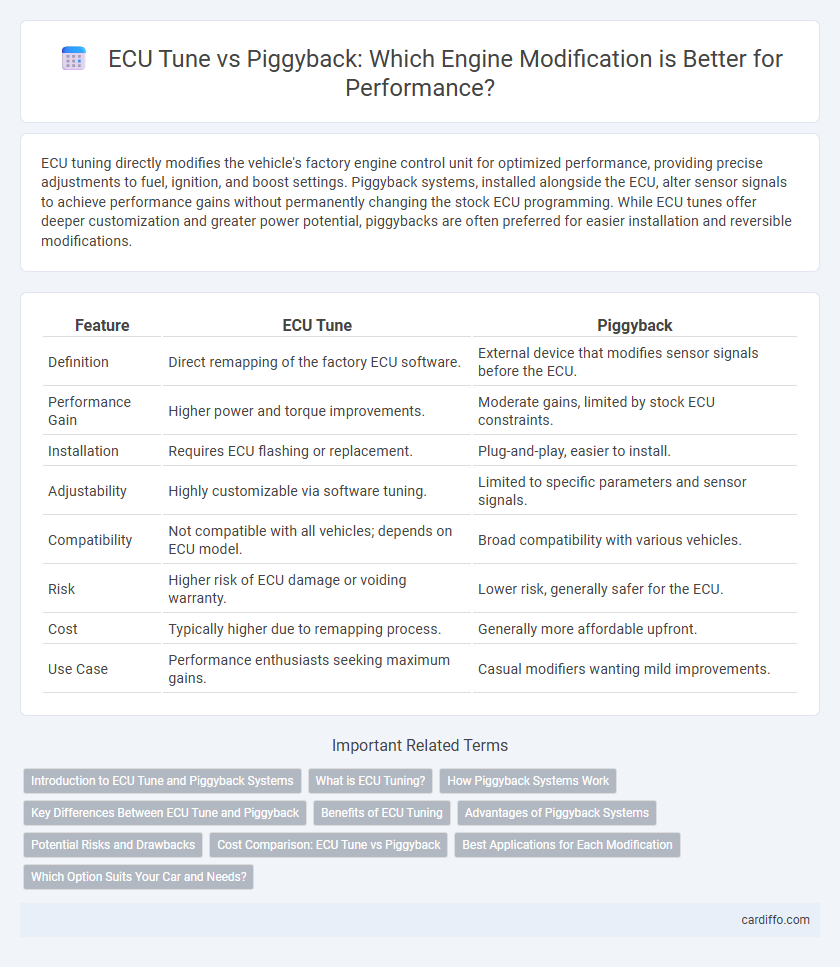ECU tuning directly modifies the vehicle's factory engine control unit for optimized performance, providing precise adjustments to fuel, ignition, and boost settings. Piggyback systems, installed alongside the ECU, alter sensor signals to achieve performance gains without permanently changing the stock ECU programming. While ECU tunes offer deeper customization and greater power potential, piggybacks are often preferred for easier installation and reversible modifications.
Table of Comparison
| Feature | ECU Tune | Piggyback |
|---|---|---|
| Definition | Direct remapping of the factory ECU software. | External device that modifies sensor signals before the ECU. |
| Performance Gain | Higher power and torque improvements. | Moderate gains, limited by stock ECU constraints. |
| Installation | Requires ECU flashing or replacement. | Plug-and-play, easier to install. |
| Adjustability | Highly customizable via software tuning. | Limited to specific parameters and sensor signals. |
| Compatibility | Not compatible with all vehicles; depends on ECU model. | Broad compatibility with various vehicles. |
| Risk | Higher risk of ECU damage or voiding warranty. | Lower risk, generally safer for the ECU. |
| Cost | Typically higher due to remapping process. | Generally more affordable upfront. |
| Use Case | Performance enthusiasts seeking maximum gains. | Casual modifiers wanting mild improvements. |
Introduction to ECU Tune and Piggyback Systems
ECU tuning modifies the engine control unit's software to optimize ignition timing, fuel delivery, and boost pressure for enhanced performance. Piggyback systems intercept and alter sensor signals before they reach the ECU, allowing adjustments without rewriting the ECU code. Both methods target improved power output and drivability but differ in complexity, cost, and customization potential.
What is ECU Tuning?
ECU tuning involves reprogramming the vehicle's Engine Control Unit to optimize engine performance and fuel efficiency by adjusting parameters like air-fuel ratio, ignition timing, and boost pressure. This modification provides precise control over the engine's functions, enabling significant power gains and improved throttle response. Unlike piggyback systems, ECU tuning directly alters the factory software, resulting in a more integrated and customizable enhancement.
How Piggyback Systems Work
Piggyback systems function by intercepting and modifying sensor signals before they reach the ECU, allowing for adjusted fuel maps and ignition timing without altering the ECU's base firmware. These devices work alongside the stock ECU by manipulating inputs like throttle position, oxygen sensor data, and boost pressure to optimize engine performance. Compared to full ECU tunes, piggyback systems offer a reversible and less invasive modification method, often preferred for maintaining vehicle warranty and simpler installation.
Key Differences Between ECU Tune and Piggyback
ECU tune involves directly reprogramming the vehicle's engine control unit to optimize performance parameters such as fuel delivery, ignition timing, and boost pressure, enabling comprehensive control and customization. Piggyback systems use an external module that intercepts and modifies sensor signals before they reach the ECU, offering a less invasive and easier-to-install alternative with limited adjustment capabilities. The key differences lie in the depth of control, installation complexity, and the potential for performance gains, with ECU tuning providing full access to engine maps while piggybacks primarily adjust specific signal inputs.
Benefits of ECU Tuning
ECU tuning offers precise control over engine parameters by directly optimizing the factory engine control unit, resulting in improved horsepower, torque, and fuel efficiency. Unlike piggyback systems that only modify signals, ECU tuning provides seamless integration with the vehicle's sensors and adaptive systems, enhancing reliability and drivability. This method also allows for customized mapping tailored to specific vehicle modifications, maximizing performance gains without compromising engine safety.
Advantages of Piggyback Systems
Piggyback systems offer significant advantages in ECU tuning by allowing modifications without altering the factory ECU, preserving warranty and maintaining stock safety parameters. These systems provide greater flexibility for specific adjustments like boost control, fuel trim, and ignition timing while enabling easy reversibility and compatibility with OEM diagnostics. Their plug-and-play design reduces installation complexity, making them a practical choice for enthusiasts seeking performance gains without deep electronic intervention.
Potential Risks and Drawbacks
ECU tunes can offer comprehensive performance improvements but carry risks such as voiding warranties, increased engine wear, and potential software corruption leading to costly repairs. Piggyback systems avoid altering the ECU's original software, reducing the chance of permanent damage, yet may cause compatibility issues, limited tuning flexibility, and intermittent sensor errors. Both methods require careful consideration of vehicle make, model, and driving conditions to minimize potential drawbacks and ensure safe modification.
Cost Comparison: ECU Tune vs Piggyback
ECU tuning typically incurs higher upfront costs due to the need for specialized software and technical expertise, often ranging from $400 to $1,200 depending on the vehicle and tuner. Piggyback systems generally cost between $300 and $700, offering a more budget-friendly alternative by intercepting and modifying sensor signals without rewriting the ECU firmware. While ECU tunes provide more precise and comprehensive engine management, piggybacks remain a cost-effective solution for performance improvements without extensive modifications.
Best Applications for Each Modification
ECU tunes offer comprehensive control over engine parameters, making them ideal for maximizing performance in heavily modified vehicles or those requiring precise fuel and ignition mapping adjustments. Piggyback systems are best suited for moderate performance enhancements, as they allow adjustments without fully rewriting the ECU's software, preserving factory safeguards and simplifying reversibility. Choose ECU tuning for race or track-focused setups demanding aggressive calibrations and piggybacks for street-driven or lightly modified cars seeking easy installation and safe horsepower gains.
Which Option Suits Your Car and Needs?
Choosing between an ECU tune and a piggyback system depends on your car's make, model, and desired performance gains. ECU tuning offers comprehensive control by directly modifying the factory engine management software, ideal for those seeking maximum power and efficiency improvements. Piggyback systems provide a safer, more reversible option by intercepting sensor signals, making them suitable for mild enhancements and vehicles with locked or unsupported ECUs.
ECU tune vs piggyback Infographic

 cardiffo.com
cardiffo.com